Yoga Course : 200-Hour TTC
The 200 Hours Yoga Teacher Training in Rishikesh
Join our 200 hour yoga teacher training in rishikesh and embark on a transformative journey. This course blends traditional yoga practices with modern insights, guiding you through asanas, pranayama, meditation, and the profound teachings of yoga philosophy.
Open to all levels, from beginners to advanced practitioners, our program provides a supportive space to deepen your practice, with a curriculum that includes yoga postures, breath control, meditation, and Ayurvedic principles tailored to individual needs. You'll explore ancient texts like the Yoga Sutras, Samkhya philosophy, and the Upanishads, gaining a well-rounded understanding of yoga’s core principles.
Our experienced instructors respect each student’s pace, offering personalized guidance to ensure a strong foundation in both body and mind. The program also delves into Sanskrit, mantras, and Naada yoga (the yoga of sound), awakening inner energies through chanting and sound meditation.
Whether you’re aiming to teach or simply enrich your own practice, our course equips you with the tools to grow spiritually and physically, grounded in India’s natural sciences and cultural heritage. Join us Yoga in Rishikesh to practice yoga next to the Ganga!
Course Details
Duration:
23 Days
Module:
Residential with Meals
Level:
Beginner to Intermediate
Certification:
Yoga Alliance
Style:
Hatha - Alignment
200h YTTC Price
Shared Room
Private Room
$1650
$1800
Shared Room
$1650
Private Room
$1800
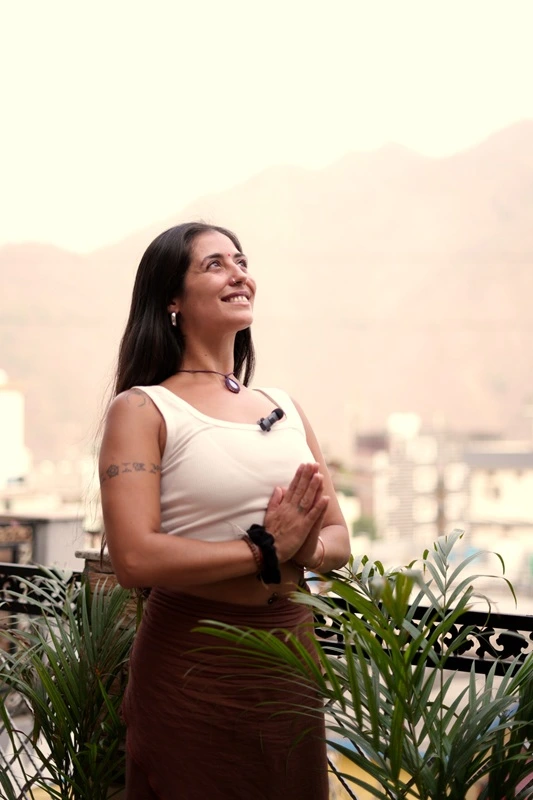
Prakruti Yogashala's Guide to the Transformative 200-Hour Yoga TTC in Rishikesh
The curriculum also includes a focus on Sanskrit, enabling students to grasp the nuances of mantras, chants, and yoga terminology. Additionally, participants are introduced to Indian classical art forms, known as the 5th Veda, which facilitate self-exploration through aesthetics and music. Nada yoga, the yoga of sound, receives special emphasis, as students are guided in the sacred practice of chanting the primordial sound of Aum to awaken latent energies safely and effectively. Moreover, students learn to harness the innate power of their hands and feet to deepen their yoga practice and unlock the hidden potential within the body.
Explore the core principles of a 200-hour Yoga TTC In Prakruti Yogashala
Embark on a transformative journey with our 200 hour yoga teacher training course in the serene setting of Rishikesh. The curriculum is an intricate blend of traditional practices and philosophical teachings. It includes an in-depth study of asana (postures), pranayama (breathwork), and meditation, along with a special focus on Ayurvedic principles, understanding one’s Prakriti (body type), and dietary guidelines tailored to individual needs.Nada yoga, the yoga of sound, receives special emphasis, as students are guided in the sacred practice of chanting the primordial sound of Aum to awaken latent energies safely and effectively. Moreover, students learn to harness the innate power of their hands and feet to deepen their yoga practice and unlock the hidden potential within the body.


Designed a clear and organized curriculum for a 200-hour Yoga (TTC)
Experience the rich tapestry of yoga through an exploration of Samkhya philosophy, Jain Darshana, and the profound wisdom of the Upanishads. Our yoga ttc course is designed to offer a comprehensive understanding of yoga’s core principles, fostering stable spiritual growth rooted in India’s natural sciences and cultural heritage.
All level candidates are welcome to join our 200 Hour Yoga TTC in Rishikesh
Open to enthusiasts of all levels, from beginners to advanced practitioners, our 200 hour yoga teacher training in india provides an inclusive and supportive environment. Whether you are taking your first steps in yoga or seeking to deepen your practice, our training equips you with the knowledge and skills to embark on a transformative journey both as a practitioner and a teacher. Join us in embracing the path of yoga, immersing yourself in its timeless wisdom and practices.
Yoga Philosophy
In this 200-hour TTC, you will learn about a wide range of practical and theoretical knowledge with a specific emphasis on Yoga (practical way of living), Samkhya philosophy (step to step guide), Jain Darshana for precise understanding of karma, and the profound wisdom of the Upanishads (sacred texts of Indian literature). Our course is designed to offer a comprehensive understanding of yoga’s core principles, fostering stable spiritual growth rooted in India’s natural sciences and cultural heritage. Yoga is not just philosophy it’s a darshan which literally means lens of realityNada yoga, the yoga of sound, receives special emphasis, as students are guided in the sacred practice of chanting the primordial sound of Aum to awaken latent energies safely and effectively. Moreover, students learn to harness the innate power of their hands and feet to deepen their yoga practice and unlock the hidden potential within the body.
- History of yoga
- Yoga Sutras of Patanjali - chapter 1 and 2
- Types of yoga
- The Eight Limbs of Yoga: Yamas and Niyamas
- Philosophy behind Asanas
- Concentration (Dharana) and its power
- The Universe (Brahman)
- Kundalini
- Chakras
- Karma from Jain Darshsnas
- Aspects of mind with yoga and Samkhya darshan
- Knowing the mind, ego, intellect and consciousness
- Samadhi
- Introducing Bhagavad Gita
- Jaina darshan for theory of karma
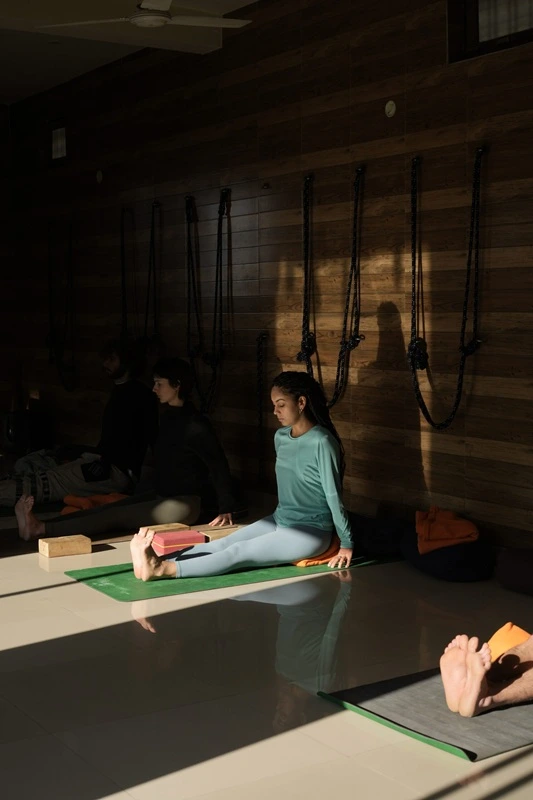
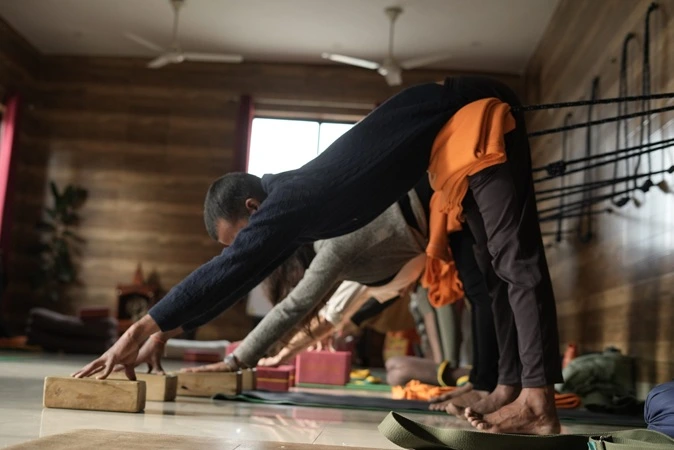
Hatha Yoga
We use the techniques of Hatha Yoga to stabilize and unlock different movements of the body. We use a lot of props to unlock the breath. Once the breath is open and stabilized, the journey of meditation becomes a natural state.Nada yoga, the yoga of sound, receives special emphasis, as students are guided in the sacred practice of chanting the primordial sound of Aum to awaken latent energies safely and effectively. Moreover, students learn to harness the innate power of their hands and feet to deepen their yoga practice and unlock the hidden potential within the body.
- Physically first to understand and unlock different movements of body
- To know that palms control upper body, feet control lower body
- To know how the breath works, what is the movement of the body and breath
- Important sequences of yoga practices: hip opening series, backbend sequence, back ache sequence, restorative sequence, arm balancing sequence, forward fold series, warrior series, inversion
- Yogic Jogging
- To know how to use different props : chair, belt, block, bolster, ropes and much more
- Bandhas/Bio-Energetic locks
Pranayama
The fire of pranayama purifies the mind, body and speech. Our body is built to breathe. Breath is one of the most important elements of yogic practices. Pranayama practices also increase your digestive fire, your mental power, and general well being.
- Mudras and bandhas
- Yoga cleansing Neti (Jal, rubber)
- Kapalbhati (breath of fire)
- Trataka
- Agnisar Kriya
- Anulom Vilom
- Shatkarmas
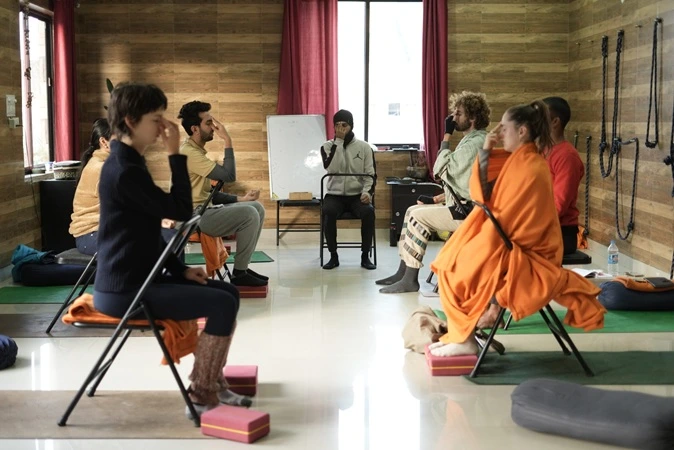

Yoga Nidra
One of the first things in a yogi’s journey is to learn how to relax. Yoga Nidra helps to reach higher states of consciousness that have the power to heal your traumas.
- Basics of yoga Nidra
- Benefits
- Science behind yoga Nidra
- 4 states of consciousness
- Basic relaxation
- Tension relaxation
- Relaxation of full body
- Sleep control
Mantra Chanting
The practice of mantras has been considered one of the ways to tune with your divine powers. It energizes your physical, mental and spiritual body. It also purifies your speech, builds subtle awareness in the body and helps you attain higher states of consciousness.
- Meaning of mantra
- Physiology of sounds and vibrations
- Origin
- Healing qualities
- Science behind the mantras
- Primordial sounds and their meanings
- 20 powerful mantras their chants and meanings
- Kundalini meditation through mantras
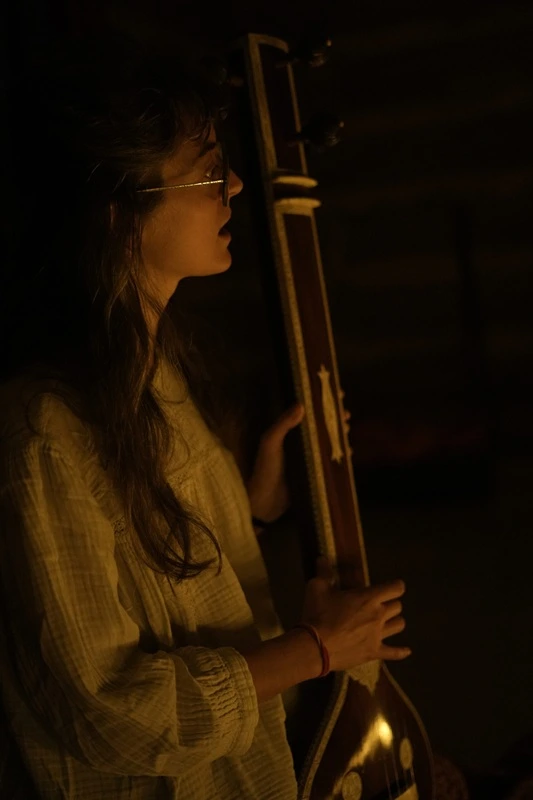
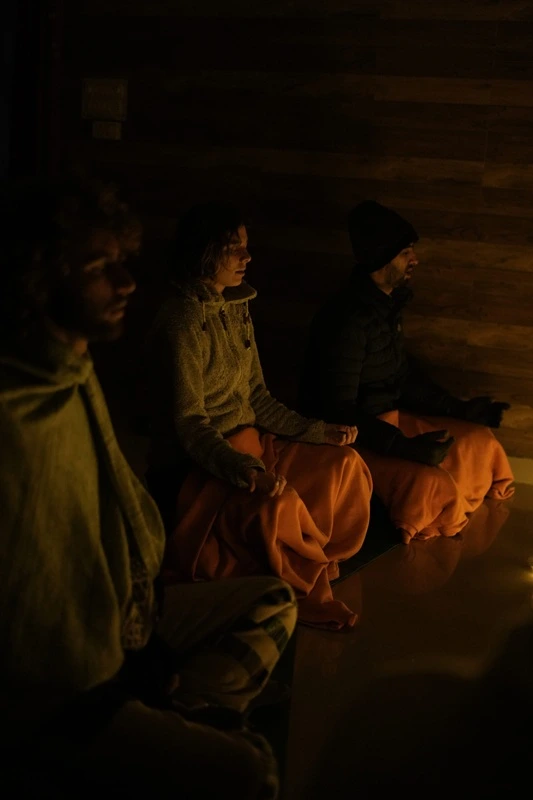
Meditation (Dhyanam)
Meditation is a gateway to excellence for anything we do in life. If we learn to focus on one thing for a prolonged period of time, it can become our portal to samadhi. Meditation improves your attention span, brings purification in mind, and harmonizes your relations in life. It gives you a sense of detachment to steer through difficult situations in life. The path from duality to non duality is meditation. The source of all your mystical powers and everyday well-being is meditation.
- Introduction and preparation
- Breathing awareness and mindfulness
- Aum meditation
- Mantra meditation
- Trataka (candle gazing)
- Dynamic (Osho) meditation
- Nadabrahma meditation
- Tantric and Kundalini meditation
- Practicing silence
- Techniques to improve concentration
- Ajapa Meditation
- Japa meditation
- Antar Mouna
Yoga Anatomy
You will learn the theoretical aspects of yoga poses, movements of the body so we have a clear understanding of what to expect in the posture, to know for certain what is the movement about, to avoid injuries, to know what are the biomechanical movements of the body. You will be able to see that your body is the most intelligent and beautiful creation of this universe.
- Brief overview
- Story of evolution of structure
- Physiology and System
- Musculoskeletal system: In detail for better understanding of asana practice
- Guidelines to asana anatomy and alingment
- Muscle functions during joint movements
- Nervous system: Sympathetic and Parasympathetic nervous system
- Respiratory system
- Circulatory system
- Gastointestenial system
- Endocrine system
- Organs
- Nadis and Chakras
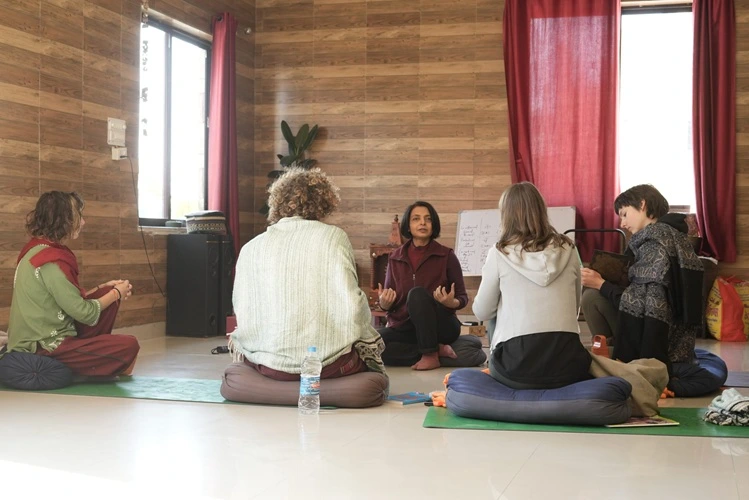
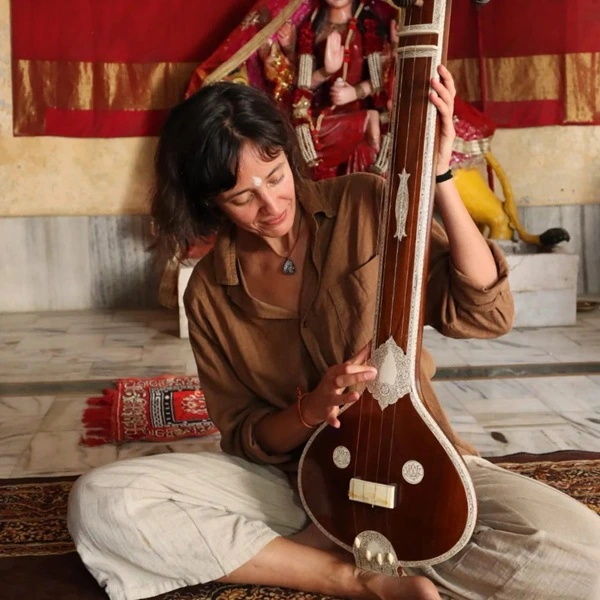
Introduction to Indian classical Arts & Music
The Indian classical arts are solely designed to uplift human conditioning be it psychological, physical and spiritual. It focuses on rewiring neural patterns of the human mind to put you in a relaxed and focused state of mind, where it becomes easier to get in a meditative state. Classical Indian dance is a very important part of our yogic culture. You will be taught various mudras of different limbs and how to connect them with emotions and movement in classical Indian dance. These dances have a beautiful effect on the mind and body and have a great meaning behind them. All the great yogis were great artists. If there is swara, there is ishwara.
- 7 sounds of life
- Voice activation on tanpura (drone instrument)
- Practice of Om on tanpura
- Chant on tanpura
- Meditation on ragas
- Nava rasa theory
Ayurveda
When we say Yoga is a journey of self, it is important to tune your body as it is the vessel of the self. Find tuning your physical and mental body also involves what kind of food fits you, what body type you have, what is your thinking pattern, what are your doshas, etc. Ayurveda helps you understand your system, how to identify the imbalances and how to prevent them to stay healthy.Classical Indian dance is a very important part of our yogic culture. You will be taught various mudras of different limbs and how to connect them with emotions and movement in classical Indian dance. These dances have a beautiful effect on the mind and body and have a great meaning behind them. All the great yogis were great artists. If there is swara, there is ishwara.
- Learn about prakriti/vikriti
- Doshas and Pancha Tatva
- Triguna and its association with food
- Nutrition and cooking class
- Ayurveda for Healthy life
- Ayurvedic Din charya
- Ayurvedic Herbs for food and medicine
- 6 flavors that affect your consciousness
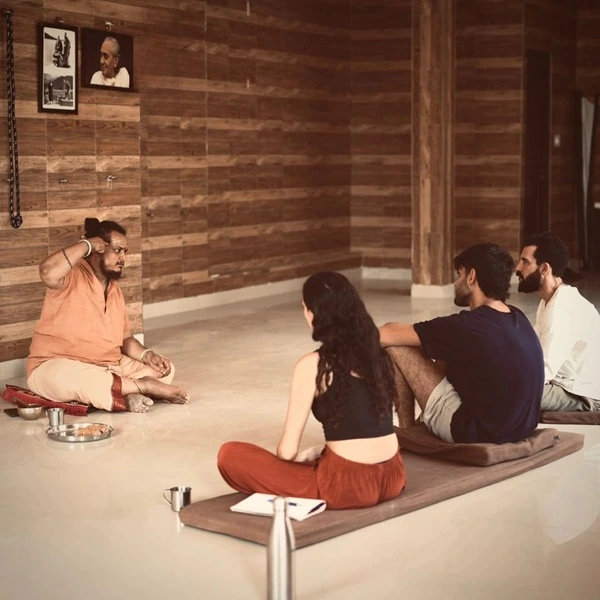
Experience the harmonious flow of learning and self-discovery in our daily schedule, designed to nurture your mind, body, and spirit amidst the serene landscapes of Rishikesh, India.
Time
Work
What makes Prakrutiyogashala unique in Rishikesh?
Prakrutiyogashala is the first school to introduce Sanskrit and its semantics of Sanskrit in Yoga Teacher Training programs in Rishikesh
What'a the eligibility & criteria to join this yoga course?
You are either Beginner, Intermediate or Advanced you can easily join.
What are the Yoga Styles in your syllabus?
Therapeutic/Iyengar
Hatha
Vinyasa
Yin
Nidra
Ashtanga
What are the Asana's and Topics you cover?
Ashtanga / Vinyasa Flow yoga postures (asana)
Surya Namaskar A
Surya Namaskar B
Primary Series:
1. Padangusthasana
2. Padahastasana
3. Utthita Trikonasana
4. Parivrtta Trikonasana
5. Utthita Parsvakonasana
6. Parivrtta Parsvakonasana
7. Prasarita Padottanasana A B C & D
8. Parsvottanasana
9. Eka Pada Padangusthasana A B C & D
10. Ardha Baddha Padmottanasana
11. Utkatasana
12. Virabhadrasana A & B
13. Dandasana
14. Paschimottanasana A B C & D
15. Purvottanasana
16. Ardha Baddha Padma Uttanasana
17. Triang Mukhaikapada Paschimottanasana
18. Janu Sirsasana A B & C
19. Marichyasana A B C & D
20. Navasana
21. Bhujapidasana
22. Kurmasana
23. Supta Kurmasana
24. Garbha Pindasana
25. Kukkutasana
27. Konasana
28. Upavistha Konasana
29. Supta Konasana
30. Supta Padangusthasana A & B
31. Ubhaya Padangusthasana
32. Urdhva Mukha Paschimottanasana
33. Setu Bandhasana
34. Urdhva Dhanurasana
35. Salamba Sarvangasana
36. Halasana
37. Karnapidasana
38. Urdhva Pindasana
39. Matsyasana
40. Urdhva Padmasana
41. Sirsasana
42. Urdhva Dandasana
43. Baddha Padmasana
44. Yoga Mudra
45. Uplutih
46. Savasana
What are the important sequences of yoga practices?
1.Hip opening series
2.Backbend sequence
3.Back ache sequence
4.Restorative sequence
5.Arm balancing sequence
6.Forward fold series
7.Warrior series
8.Inversion
9.Yogic Jogging
Could you provide details about your 200-hour YTT course syllabus?
1.Definition of Prana (vital force energy)
2.Intorduction to pranayama
3.Difference between Prana and breath
4.Movement of prana in the body
5.Nadis (energy channels)
6.Chakras
7.Chakras and pranayama
8.Aim and objectives
9.Benefits and contraindications
10.Relation of breath with mind and emotion
11.Emotional purification treatment
12.Pranayama and aging
13.Different techniques
14.Preparation and general guidelines
15.Quality of breathing
16.Life span and breathing
17.Abdominal breathing
18.Clavicular breathing
19.Thoracic breathing
20.Diaphragmatic breathing
21.Yogic breathing
22.Ujjayi
23.Bhastrika
24.Kapalbhati
25.Nadi Shodhana
26.Surya and Chandra Bhedi
27.Bhramari
28.Sheetali and Sheetkari Breathing
29.Snoring and controlling it
30.Sitting postures for pranayama and meditation
31.Sukhasana (Easy Pose)
32.Ardha Padmasana (Half-lotus)
33.Swastikasana (Auspicious Pose)
34.Siddhasana (Accomplish pose)
35.Mudras (yoga gestures)
36.Jnana mudra
37.Chin mudra
38.Dhyana mudra
39.Yoni mudra
40.Shambhavi mudra
41.Bhairava mudra
42.Nasikagra drishti mudra
43.Khechari Mudra
44.Bandhas (energy lock)
45.Preparation for Bandhas
46.Granthis – 3 knots in the spine
47.Energy blockages and their removal
48.Cleaning the energy through bandha
49.Kundalini awakening with the help of Bandhas
50.Why is Bandhas an advanced practice
51.Mula Bandha (Root Lock)
52.Uddiyana Bandha (Abdominal Lock)
53.Jalandhara Bandha (Thoracic Lock)
54.Maha Bandha-Mula + Uddiyana + Jalandhara (Great Lock)
What will you gain from this course at Prakruti Yogashala?
This comprehensive course aims to revolutionize your understanding and practice of yoga, integrating ancient wisdom with modern science. Delve into the depths of Sanskrit, Ayurveda, and yoga philosophy to forge a solid foundation in Indian culture. Through rigorous training in traditional yoga techniques, complemented by insights from contemporary neuroscience, participants will embark on a transformative journey towards self-realization. Learn authentic yoga from an indigenous yoga school, acquiring both theoretical knowledge and practical skills. Obtain a globally recognized certification from Yoga Alliance, ensuring credibility and proficiency in your practice. Under the guidance of highly qualified instructors, steeped in the lineage of self-realized beings, delve into the intricacies of yoga, Sanskrit semantics, and Ayurveda.Physically, discover the significance of posture and breath, laying the groundwork for advanced practices like pranayama. Mentally, challenge conventional perspectives and cultivate a holistic understanding of reality through the lens of yoga philosophy. Embrace the power of sound through Nada yoga, harnessing the transformative potential of mantras and chants. Unlock the dormant energies within your body, aligning your chakras and raising your kundalini safely and effectively. Gain insight into your unique body constitution (Prakriti) and dietary requirements, guided by the principles of Ayurveda. Explore the fundamental principles of the universe and the self, as elucidated in yoga, Samkhya philosophy, Jain darshana, and Upanishads. Embark on a journey of self-discovery and spiritual growth, empowered by the timeless wisdom of Indian culture and the transformative practices of yoga.
Who is this course suitable for, and what can I expect to gain from it?
This course is suitable for individuals with a strong desire to deepen their understanding and practice of yoga, including its techniques and philosophy. Whether you’re a novice or an experienced practitioner, you can expect to develop a deeper understanding of Hatha and Ashtanga yoga, refine your practice, and embark on a transformative journey of self-discovery.
Is prior experience or certification required to enroll, and will I receive certification upon completion?
No prior experience or certification is required. This course is open to anyone who has a passion for learning and is open to exploring new ideas. Upon successful completion of the course, you will receive a certification recognized by Yoga Alliance, marking your achievement and expertise in yoga practice and philosophy.No prior experience or certification is required. This course is open to anyone who has a passion for learning and is open to exploring new ideas. Upon successful completion of the course, you will receive a certification recognized by Yoga Alliance, marking your achievement and expertise in yoga practice and philosophy.
Where is the course conducted, and how long is the course?
The course is conducted In Prakruti Yogshala at Laxman Jhula Rd, Tapovan, Rishikesh, Uttarakhand 249137. Renowned for its immersive learning environment and experienced instructors. The duration of the course may vary, but it typically offers a comprehensive curriculum covering theoretical and practical aspects of yoga.
What can I expect in terms of personalized guidance and course format?
Our experienced instructors are dedicated to providing personalized guidance and support to help you maximize your learning and growth throughout the course. Classes may be conducted in-person or online, providing flexibility for participants.
What's the purpose and use of of Classical Indian music & arts in Yoga?
The design of classical Indian music is to take you in flow state by slowing down your mind, heart beat and rewire your neural patterns to improve attention span, create beauty inside. Universe is the creation of sound so studying sound is very important to study the self.
1.Teaching practice
2.Demonstration
3.Alignment
4.Adjustment
5.Instructions
6.Teaching methodology
7.Positive communication
8.Building trust and friendship
9.Time management
10.Qualities of a good teacher
11.Demonstrating, observing, assisting, and correcting
12.Proper use of voice in class
13.Mental and emotional class preparation
14.Structure planning
15.Assessments will be based on:
16.Written and oral test
17.Attendance
18.Performance
19.Conduct
Book now your 200-hour Yoga TTC with:
- A batch of only 9 people
- A team of qualified and available teachers
- Extra topics beyond the Yoga Alliance curriculum : semantic of sanskrit, ayurveda, naada yoga
Fees:
$1800
$1650
The price includes 23 days of:
- Clean accommodation
- 3 daily meals
- Tuition fees
- 1 excursion
Frequently Asked Questions
Find answers to all the questions you had in mind or may have later.
What is the 200 Hours TTC program?
The 200 Hours TTC is a foundational yoga teacher training course that certifies participants to teach yoga professionally.
Is this program accredited by Yoga Alliance?
Yes, most 200-hour TTC programs are recognized by Yoga Alliance, making you eligible to register as a certified yoga teacher (RYT-200).
What is included in the 200 Hours TTC curriculum?
The course covers asana practice, anatomy, teaching methodology, pranayama, meditation, philosophy, and ethics of teaching yoga.
Who can enroll in this program?
Anyone interested in deepening their practice or becoming a certified yoga instructor can enroll. Some programs may require prior yoga experience.
How long does it take to complete the 200 Hours TTC?
The course can be completed in 3-5 weeks for intensive programs or spread over several months in part-time formats.
Can I teach yoga immediately after completing this course?
Yes, upon certification, you can start teaching yoga classes in studios, gyms, or online platforms.
What style of yoga is taught in the course?
The program may focus on Hatha, Vinyasa, Ashtanga, or a combination of different styles, depending on the institution.
What career opportunities are available after completing this program?
Graduates can work as yoga teachers in studios, wellness centers, corporate settings, or start their own yoga business.
What if I miss a few sessions?
Most programs require full attendance, but some offer makeup classes or online alternatives for missed sessions.
You haven’t found the answer to your question? Please contact us at prakrutiyogashala@gmail.com.